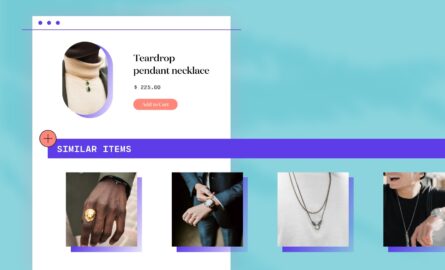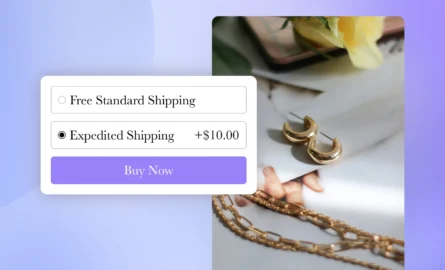What is Average Order Value (AOV) & 6 Ways You Can Increase It
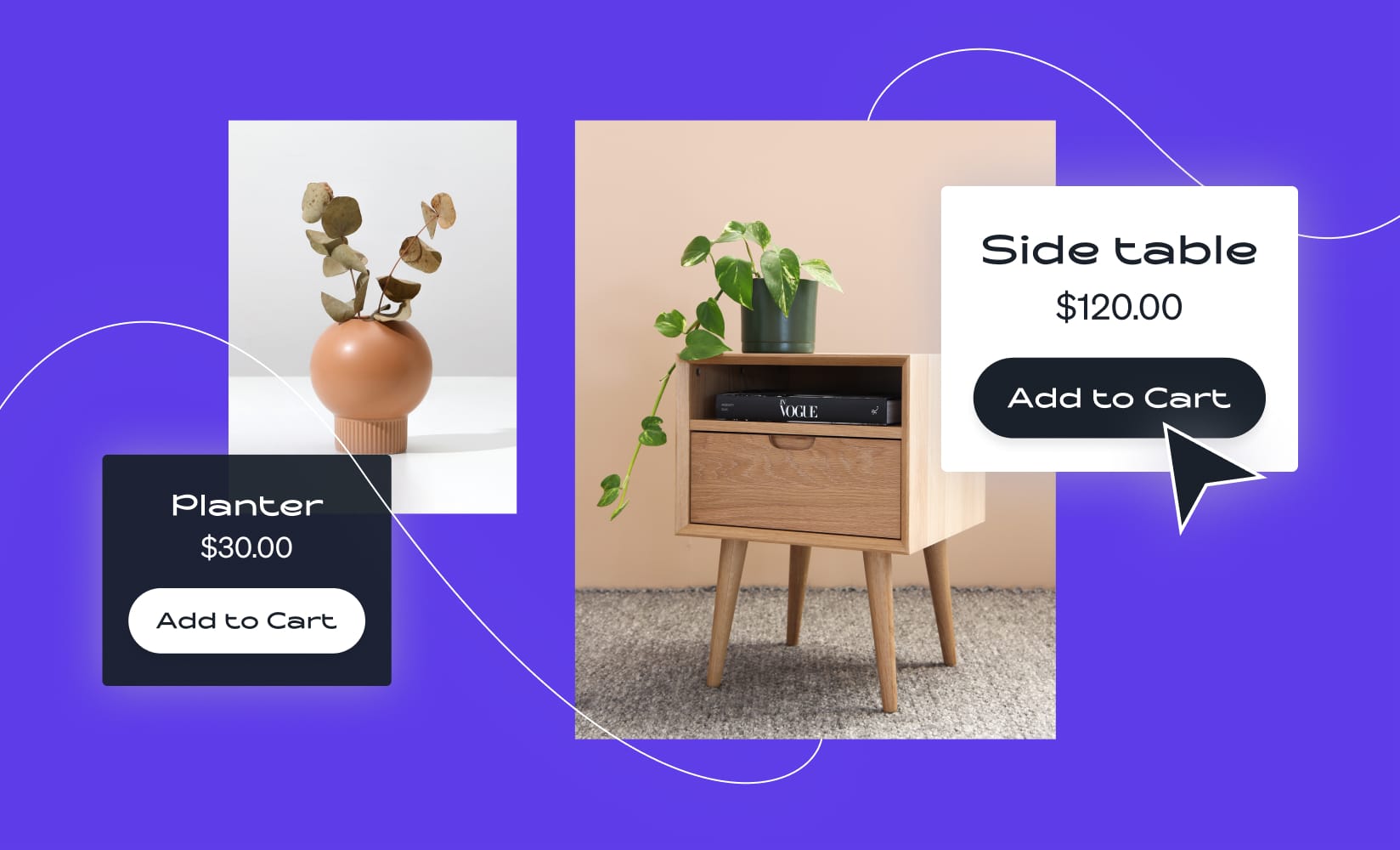
It’s getting more difficult to find and convert customers in ecommerce.
New data privacy laws limit how well merchants can refine their audiences, making ad spend less effective and more expensive.
On top of that, more ecommerce sellers are rejoining the competition after a long pandemic that interrupted supply chains.
That means smart merchants must turn to alternative tactics to build a growing business. Rather than investing everything into acquisition, it’s time to focus more on metrics like average order value (AOV).
Whereas customer lifetime value (CLV) measures how well you retain the customers you acquire, AOV measures how well you leverage each conversion.
In this article, we’ll dive into average order value and cover:
- The importance of AOV
- How to calculate your average order value
- Strategies to increase your average order value
#cta-visual-pb#<cta-title>Use smart UX design to boost AOV<cta-title>Build a store that delivers what your shoppers want with an intuitive drag and drop page builder.Start designing today

Generally, you want your AOV to be as high as possible. More money from fewer orders is pretty great, right?
Larger orders mean more revenue and profit for your business. Plus, you stand to earn more from larger orders due to shipping and transaction fees.
For example, if you get 10 orders worth $100 each, you may net $1,000 but pay 10 different shipping costs and transaction fees. Alternatively, if you get a single order for $1,000, you’ll only have to pay shipping and fees once.
Larger orders are also more efficient when it comes to acquisition costs.
Think about how much time and effort it costs you to make a single sale—you may invest in ads, SEO, landing page optimization, and more to build awareness of your brand and drive traffic to your store.
Getting larger orders for every conversion helps utilize your acquisition spend more efficiently and ensures your advertising dollars go further.
Larger carts also mean more return on your investment (ROI) immediately. You should always strive for customer loyalty, but you can’t depend on it.
Whereas customer lifetime value (CLV) measures returns across potentially multiple purchases from one customer, AOV gauges how efficient you were at converting and getting a return on a single purchase.
AOV is a measure of ROI that doesn’t rely on future—unrealized—sales.
Boosting AOV allows you to maximize the value of your customers while they’re still your customers. It gives you access to funds you can use immediately to grow your business and acquire and retain even more customers.
Now that we’ve gone over why AOV is such an essential metric for ecommerce businesses, let’s talk about how to measure the average order values for your store.
AOV represents the average amount of money that a customer spends when purchasing.
You can find it by dividing your total revenue by the number of orders placed in your store. Here’s the average order value formula:
#cta-paragraph-pb#Average Order Value (AOV) = Revenue ÷ Number of Orders
For example, if you had $100,000 in revenue and 500 orders placed in February, your AOV for the month would be $200.
#cta-paragraph-pb#$100,000 ÷ 500 = $200
Where to find your average order value
Since AOV is such a critical business metric, you may also find the measurement already calculated for your store in your seller dashboards.
For example, Shopify merchants can see their average order values by going to Analytics > Reports. Find the Sales section and click to reveal all reports.
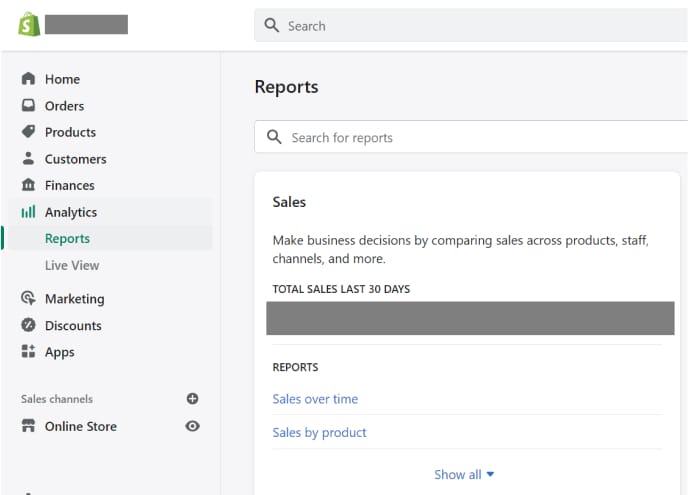
Near the bottom, you’ll see a link to Average order value over time.
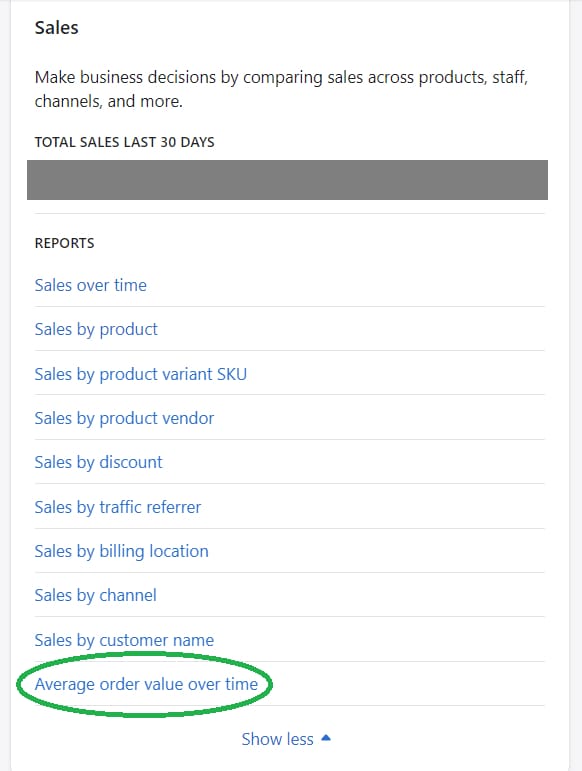
Alternatively, you can use the search bar to look up “Average order value over time.”

Increasing your AOV helps your bottom line, improves your ROI, and gives you immediate access to funds you can use to grow your business.
Stores use many different techniques to increase their AOV—from requiring cart minimums to unlock rewards to adding value-packed product bundles to their catalog.
Here are a few tactics you can use to boost average order values for your business.
1. Increase your prices
At the most basic level, raising your prices will directly increase your average cart values.
Selling products at $1 to $5 each will yield a lower average order value than selling products at $5 to $10 each, even if your shoppers buy more items.
While raising prices is the easiest way to increase AOV, it’s crucial to have a thought-out pricing strategy before making any significant cost changes.
If you raise prices too high, you may drive customers to competitors that offer better deals. Your increased AOV shouldn’t come at the expense of your sales volume.
Or, if you aren’t sure how much to charge, you could end up changing prices multiple times and confusing your shoppers. Shoppers prefer to shop with brands that don’t wobble on pricing.
2. Leverage upselling and cross-selling
It isn’t enough to just attract a visitor to a product page. Once they’re there, you need to showcase other related products as well.
Upselling and cross-selling help to ensure this.
Upselling and cross-selling are vital AOV-boosting tactics that you should be experimenting with across your sales channels.
Upselling is getting someone to upgrade their purchase, either to a more expensive version, a larger package, or a subscription.
It involves showing your visitors a better (and more expensive) product than what they’re looking at or alternative purchasing options.
For example, if a visitor is on the product page for a laptop, you could upsell them on a laptop with a bigger screen or more powerful hardware.
Cross-selling is getting shoppers to add more items to their cart, usually related products that are helpful or useful for the original item.
It involves showing the visitor products that they might want to buy in addition to the product they’re looking at.
For example, if someone is looking at a laptop, you could cross-sell the visitor laptop bags, screen protectors, and cooling fans.
Look for different opportunities to upsell and cross-sell to your customers.
For example, you may add an insert to your packages that provide a coupon for ‘Buy 3, Get 1 Free,’ or test a full-screen pop-up that allows someone to “spin the wheel” and give them a discount on a special item if they add it to their carts that day.
#cta-visual-pb#<cta-title>Make your store memorable<cta-title>Create unique on-site experiences in minutes with Shogun Page Builder’s easy drag-and-drop visual editor.Start building for free
Offer subscriptions for your perishable or consumable goods
One way to upsell customers is by adding subscription options to your product pages and highlighting the savings that come along with one.
Instead of a one-off purchase, you get recurring revenue that you can then plan for to save time and money.
For example, if you have a subscription delivery coming up, you can send it out early to ensure it arrives on time, even if you use cheaper and slower standard shipping.
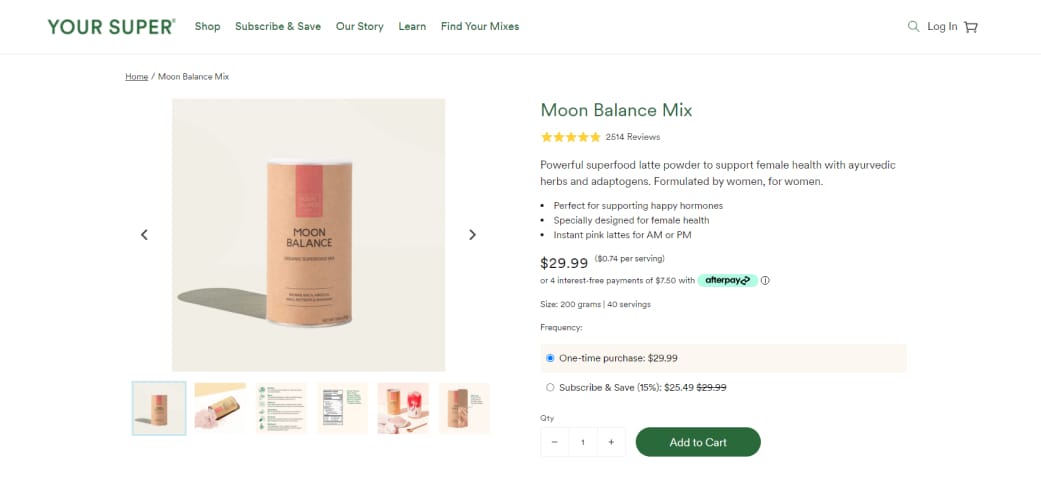
Your Super has added a “Subscribe & Save” option to their product page that highlights the savings on a subscription instead of a one-off purchase in the above example.
For Shopify stores, adding this functionality is super easy with powerful subscription apps.
Serve customized product recommendations
The first touchpoint a visitor has with your website may not be your homepage but rather a product page.
For example, someone might share a link to your product with a friend, or you may be featured in a top 10 round-up article that links directly to the item they recommend.
Unless you do something about it, those visitors may see that single product page and then leave without learning about any of the other products you offer.
By adding a recommended products section to each product page, you can utilize your traffic and use it as a launchpad to introduce your other SKUs.
Getting every visitor to see more of your catalog can lead to more sales and additional items in their shopping cart that they wouldn’t have usually clicked on.
You should also add a recommended products section to your checkout page, as this gives you one last chance to convince customers to add more items to their cart before they place their order.
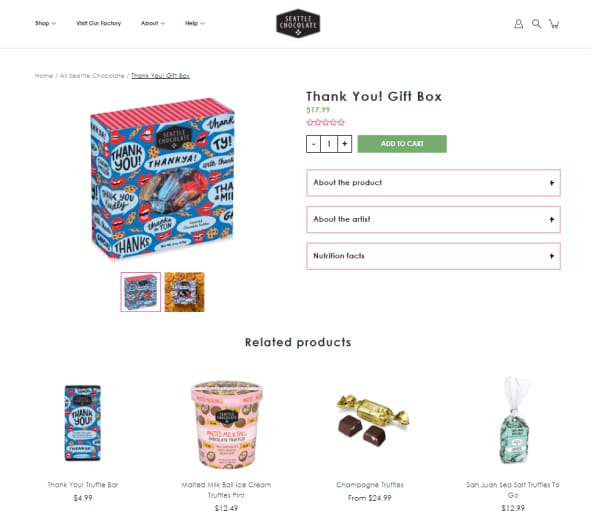
If you configure which items show based on the product page and items already in someone’s cart, you stand a higher chance of sharing something that your shoppers actually want.
For example, if someone is buying matcha, show them a matcha whisk, not a bracelet.
Personalization is critical with product recommendations, and it enhances your buyer experience drastically.
In the example above, one of the related products shown for a gift box is a truffle box with the same design (a “thank you” message). This is a great way to introduce new items and encourage shoppers to add additional goods to their carts.
#cta-mini-pb#Use Shogun Page Builder to add product recommendations across your website. Learn more
Show items that were frequently bought together
Another cross-selling tactic is to add related products on every product page.
The “Frequently bought together” section on Amazon product pages has played a key role in the company’s success—in fact, their recommendation engine generates 35% of Amazon’s revenue.
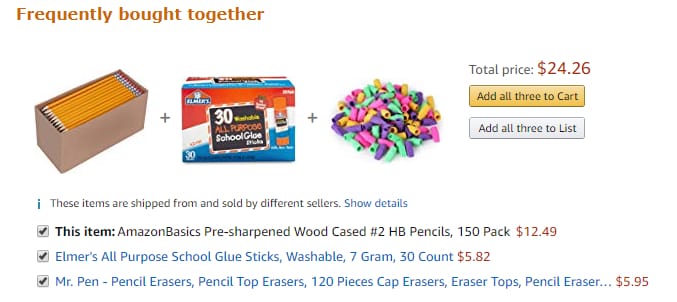
With more than $450 billion in annual revenue and 200 million monthly visitors (in the US alone), Amazon is the most successful ecommerce company in the world.
So, you would be smart to follow their example and include some version of a “Frequently bought together” section in your own store.
3. Create a loyalty program
Amazon also showcases another effective AOV-increasing technique: the loyalty program.
The Amazon Prime subscription service offers a variety of benefits to members, including free two-day shipping and access to an extensive library of original TV shows and movies.
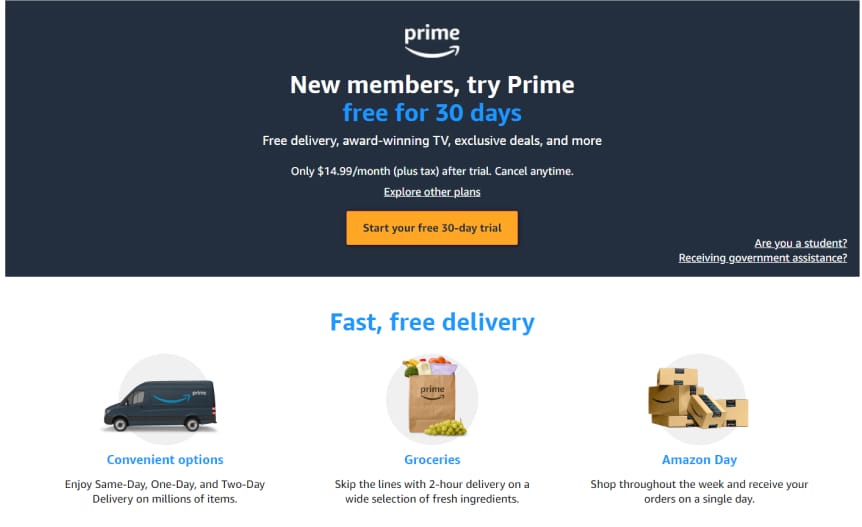
The program has become enormously popular—there are more than 200 million Prime members who leverage all the shopping perks of the program.
While subscriptions cost $14.99 per month, Amazon likely makes much more money from this program’s effect on customer behavior.
Without a Prime membership, someone might buy a few products they want on Amazon but then look elsewhere for other items they want.
But with a Prime membership, they’ve already invested in shopping on Amazon, so they have an incentive to get everything they want in an order on Amazon instead of shopping around.
In other words, Amazon Prime increases Amazon’s AOV.
You may not have the resources to start your own movie studio as a way to attract customers, but there are plenty of other perks that you can offer.
Discounts, gifts, and early access to new products are a few ways any store can build a successful loyalty program and keep customers away from the competition.
4. Bundle your items
Product bundles are groups of items sold together as a single SKU.
As these items must be purchased together by default, you tend to end up with larger carts than you would have if you sold each item individually.

You can make bundles attractive to consumers in a few different ways.
You can provide a bundle that comes with built-in savings. For example, if a shopper purchases a bundle, they get 10% off of the retail price of all the goods.
Or, you might offer exclusive items only available in a bundle. For example, you have a limited edition t-shirt with only 500 units available, with a new design each year.
These limited edition shirts can be sold as a bundle with a new line of pants from your regular catalog. The effect would be double-edged: build up hype for your limited edition items while introducing more customers to your new product.
In addition to increasing AOV, bundles can also introduce your shoppers to new items they wouldn’t have otherwise chosen.
Consider using bundles with your best-sellers to introduce new products or any other items you want to draw attention to.
#cta-mini-pb#Beardbrand increased AOV 19% with Shogun Page Builder. Learn more
5. Launch a subscription box
Subscription boxes may sound like a fancy bundle, but there are some key differences.
Customers can purchase product bundles whenever they like as a one-off purchase. On the other hand, subscription boxes are often custom bundles that ship at regular intervals.
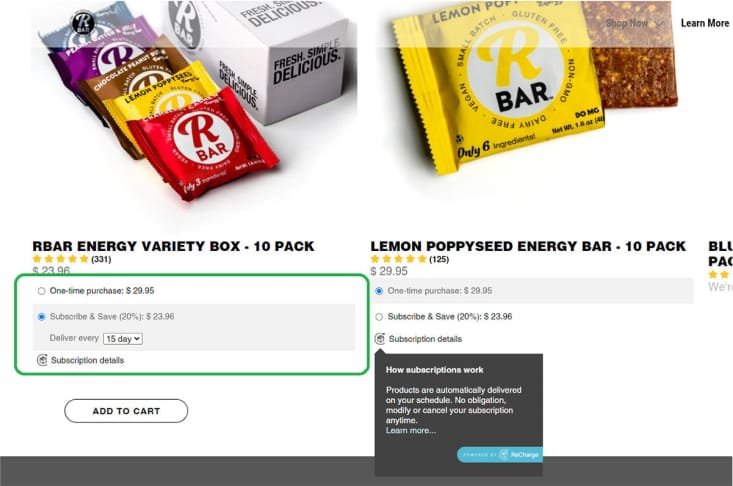
They create longer customer lifetime values (CLV) and can be configured to fit the customer’s needs.
To surprise and delight your customers, you might have a subscription box with items that change every month. These curated bundles rely on excitement and novelty.
Or you might have a subscription box that stays mostly the same, is delivered every quarter, and has one surprise item in each box. This type relies on convenience with a dash of surprise.
There are different ways to structure your subscription boxes, but they bring the best of both worlds when it comes to AOV and CLV.
6. Tie order values to rewards
Finally, you can encourage your shoppers to spend more to unlock rewards, such as free shipping.
It’s easy to see why free shipping for orders that meet a certain minimum value threshold is one of the most common promotions featured on online stores.
Shopify learned that free shipping influences purchases significantly for 75% of global shoppers.
Beyond that, 94% of shoppers have reported that they had previously taken an action to qualify for free shipping (for example, adding extra items to their cart to meet an order minimum).

In the example above, Koffee Kult customers unlock free shipping on orders of $50 or more, encouraging them to add more products and reach that threshold.
By setting an order minimum for free shipping, businesses can enjoy the sales-increasing benefit of this offer while minimizing how much it costs them—plus, it has the added effect of increasing their AOV.
You can also tie other benefits to an order minimum, such as a discount or returns eligibility, to persuade shoppers to increase the value of their carts before checkout.
Use A/B testing to perfect your AOV strategy
What works for one business won’t necessarily work for another.
The only way to know if one of the techniques listed above will actually increase your AOV is to try them out and see what happens.
But after you announce bundles, subscriptions, loyalty programs, free shipping, or anything else, how do you prove it affected AOV?
After all, there are external factors to consider in ecommerce. Perhaps the boost was due to a seasonal trend, or a competitor raised their prices.
This uncertainty is what makes A/B testing so important.
When A/B testing, you show your original website to a subset of your customers and an updated version of your website to the rest.
The goal of A/B testing is to see whether incremental changes, such as the color or placement of your CTA button, will affect conversions.
Once an A/B test has finished, you’ll be able to see whether a variable significantly changed your conversion rate and implement whichever version was more successful.
Through a series of A/B tests, you should be able to find the highest converting combination of website elements for a particular page.
Observing how different landing page changes affect conversions allows you to optimize for the highest AOVs and conversion rates in small, incremental steps that add up.
With smart A/B testing, you can learn what works and what doesn’t when it comes to landing higher average cart values.
Boost your average order values with these key strategies
Raising your average order values can create the desired domino effect in your business—with the right strategies in place, revenue growth just falls into place.
You get more revenue more quickly and share more of your products with your valued customers.
Using the tactics we covered above, such as upselling, cross-selling, loyalty programs, and more, you can enjoy larger carts and happier customers. Who doesn’t like that?
Happy selling!
#cta-visual-pb#<cta-title>Enable maximum AOV<cta-title>Craft landing pages that make your shoppers want to buy more.Start building for free

Rachel Go
Rachel is a remote marketing manager with a background in building scalable content engines. She creates content that wins customers for B2B ecommerce companies like MyFBAPrep, Shogun, and more. In the past, she has scaled organic acquisition efforts for companies like Deliverr and Skubana.

